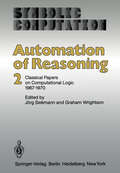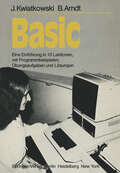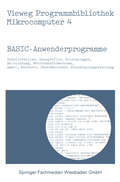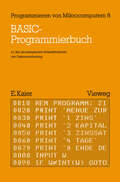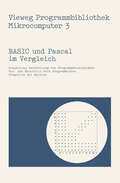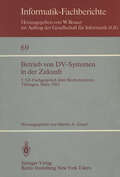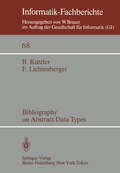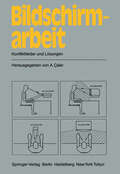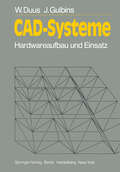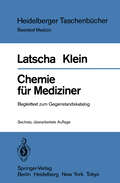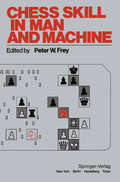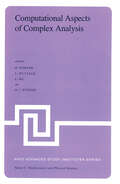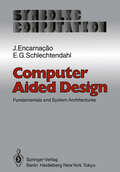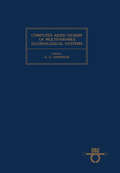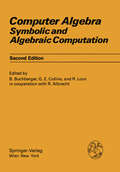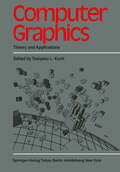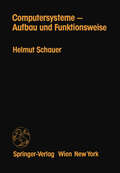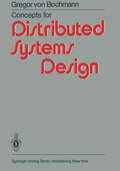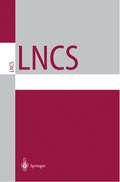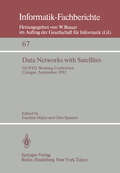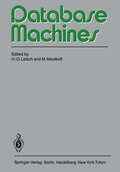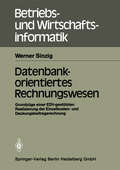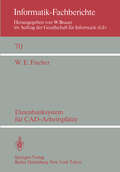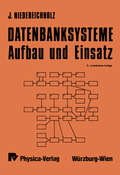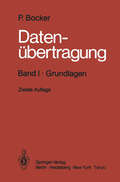- Table View
- List View
Automation of Reasoning: 2: Classical Papers on Computational Logic 1967–1970 (Symbolic Computation)
by J. Siekmann G. Wrightson"Kind of crude, but it works, boy, it works!" AZan NeweZZ to Herb Simon, Christmas 1955 In 1954 a computer program produced what appears to be the first computer generated mathematical proof: Written by M. Davis at the Institute of Advanced Studies, USA, it proved a number theoretic theorem in Presburger Arithmetic. Christmas 1955 heralded a computer program which generated the first proofs of some propositions of Principia Mathematica, developed by A. Newell, J. Shaw, and H. Simon at RAND Corporation, USA. In Sweden, H. Prawitz, D. Prawitz, and N. Voghera produced the first general program for the full first order predicate calculus to prove mathematical theorems; their computer proofs were obtained around 1957 and 1958, about the same time that H. Gelernter finished a computer program to prove simple high school geometry theorems. Since the field of computational logic (or automated theorem proving) is emerging from the ivory tower of academic research into real world applications, asserting also a definite place in many university curricula, we feel the time has corne to examine and evaluate its history. The article by Martin Davis in the first of this series of volumes traces the most influential ideas back to the 'prehistory' of early logical thought showing how these ideas influenced the underlying concepts of most early automatic theorem proving programs.
Basic: Eine Einführung in 10 Lektionen mit zahlreichen Programmbeispielen, 95 Übungsaufgaben und deren vollständigen Lösungen (Informationstechnik und Datenverarbeitung)
by J. Kwiatkowski B. ArndtBASIC-Anwenderprogramme (Vieweg-Programmbibliothek Mikrocomputer #4)
by Peter Frahm Werner Hürlimann Helmut Richter Harald Schumny Achim Stößer Wilfried WendtEinführung Von wichtigen internationalen Normungsorganisationen sind Bemühungen bekannt, einen einheitlichen, höheren BASIC-Dialekt zu entwickeln. Nach Verabschiedung solch eines Standards und weltweiter Akzeptierung wäre es erheblich einfacher als heute, BASIC-Programme zwischen Benutzern verschiedener Rechner aus zutauschen. Allerdings können Programme, die den Sprachenumfang des neuen Standards nutzen, nicht auf Systeme übertragen werden, die mit derzeitigen Quasi-Standardversionen arbeiten (wie z.B. Apple-, CBM- oder Tandy-BASIC) . Denn nur wenige Hersteller bieten schon jetzt erweiterte Dialekte, die etwa den Vorstellungen genügen, wie sie beispielsweise vom ANSI (American National Standards Institute) entwickelt wurden. Am ehesten entspricht schon das von Hewlett-Packard für die 80er Systeme entwickelte "Erweitere BASIC" den neuen Festlegungen wie z.B. CALL "Unterprogrammname" Aufruf eines Unterprogramms mit seinem Namen, IF •.. THEN ... ELSE ... zweiseitige Programm verzweigung, PRINT USING ... formatierte Ausgabe. Drei weitere Anweisungsgruppen zeichnen die Programmiersprache BASIC der Systeme wie HP-85 aus: - Graphik-Anweisungen zur Ausgabe von Meß- oder Berechnungs ergebnissen und Beschriftung von Diagrammen, z.B. SCALE, XAXIS, YAXIS, PLOT, DRAW, MOVE, LABEL, PEN - Befehle zur Behandlung von Hardware- und Software Interrupts, z.B. ON ERROR •.• GOSUB (oder GOTO) ON INTR ... ON KEY ..• Einführung ON TIMER •.• - Befehle zur Bedienung des IEC-Busses, z.B. ENTER, OUTPUT, .•• USING ... , Im Beitrag von w. Wendt und H. Schumny werden diese Möglich keiten weitgehend genutzt. Die konkrete Anwendung aus der nuklear-physikalischen Praxis kann sozusagen als Demonstration dafür angesehen werden, was künftige BASIC-Versionen erlauben.
BASIC-Programmierbuch: zu den grundlegenden Ablaufstrukturen der Datenverarbeitung (Programmieren von Mikrocomputern)
by Ekkehard KaierBASIC und Pascal im Vergleich (Vieweg-Programmbibliothek Mikrocomputer #3)
by Harald SchumnyBASIC ist heute so etwas wie eine Standard-Programmiersprache, und für viele private und berufliche Computer-Verwender ist BASIC die als erste gelernte Sprache. Das liegt vor allem an der leichten Erlernbarkeit - selbst Anfänger können bereits nach wenigen Stunden eigene Programme schreiben. Praktische Gründe für die Dominanz von BASIC sind aber auch die Dialogfähigkeit, die interaktives Arbeiten am Computer ermöglicht (Mensch-Maschine-Dialog), und die Tatsache, daß die am meisten verbreiteten Tischcom puter nur BASIC "verstehen". Häufig hört man von erfahrenen Programmierern, BASIC weise eine Reihe ernst zu nehmender Mängel und Nachteile auf, vor allem BASIC erlaubt keine strukturierte Programmierung, verleitet vielmehr zu extensiven Verzweigungen und Verschachtelungen ("Spaghetti"-Stil); es sind nur globale Variablen möglich (nur solche, die für das ganze Programm gelten), lokale Variablen z. B. in Unterprogrammen können nicht definiert werden; symbolische Adressierung ist in der Regel nicht möglich, Variablennamen sind oft viel zu kurz (meist nur 2 Zeichen); das Aneinanderhängen mehrerer Programme (chain, append oder merge) durch Zu laden vom Massenspeicher ist normalerweise nicht möglich; - WHILE-Schleifen, GASE-Strukturen und IF-THEN-ELSE werden nur äußerst selten geboten. Das stimmt .natürlich alles. Es sollte trotzdem immer ehrlich abgewogen werden, ob man auf all diese fehlenden Möglichkeiten nicht auch verzichten kann. Die weite Verbreitung von BASIC läßt den Schluß zu, daß in sehr vielen Anwendungsfällen tatsächlich darauf verzichtet werden kann.
Betrieb von DV-Systemen in der Zukunft: 5. GI-Fachgespräch über Rechenzentren Tübingen, 17./18.März 1983 (Informatik-Fachberichte #69)
by M. A. GraefBibliography on Abstract Data Types (Informatik-Fachberichte #68)
by B. Kutzler F. LichtenbergerSponsored by the "Österr. Fonds zur Förderung der Wissenschaftlichen Forschung", project nr. P4567
Bildschirmarbeit: Konfliktfelder und Lösungen (Informationstechnik und Datenverarbeitung)
by A. E. CakirInhalts}bersicht: Technisierung der Informationsverarbeitung - Gefahr oder Chance? - Technik und Umwelt. - Erfahrungen der Anwender. - Erfahrungen der Sozialpartner. - Normen und Regelungen. - Belastung und Beanspruchung. - Autorenverzeichnis. - Namen- und Sachverzeichnis.
CAD-Systeme: Hardwareaufbau und Einsatz (Informationstechnik und Datenverarbeitung)
by W. Duus J. GulbinsChemie für Mediziner: Begleittext zum Gegenstandskatalog für die Fächer der Ärztlichen Vorprüfung (Heidelberger Taschenbücher #171)
by H. P. Latscha H. A. KleinChess Skill in Man and Machine
by P. W. FreyTen years of intensive effort on computer chess have produced notable progress. Although the background information and technical details that were written in 1975 for the first edition of this book are still valid in most essential points, hardware and software refinements have had a major impact on the effectiveness of these ideas. The current crop of chess machines are performing at unexpectedly high levels. The approach epitomized by the series of programs developed by David Slate and Larry Atkin at Northwestern in the middle 1970s (i. e. , a sophisticated search algorithm using very little chess knowledge) was expected to reach an asymptbtic level of performance no higher than that of a class A player (USCF rating between 1800 and 2000). This perspective was argued quite vigorously by Eliot Hearst in Chapter 8 of the first edition and was held at that time by many chess experts. Subsequent events have clearly demonstrated that the asymptotic performance level for this type of pro gram it at least as high as the master level (USCF rating between 2200 and 2400). Current discussions now focus upon whether the earlier reser vations were wrong in principle or simply underestimated the asymptote. If there is a real barrier which will prevent this type of program from attaining a world championship level of performance, it is not evident from the steady progress which has been observed during the last decade.
Computational Aspects of Complex Analysis: Proceedings of the NATO Advanced Study Institute held at Braunlage, Harz, Germany, July 26 – August 6, 1982 (Nato Science Series C: #102)
by K. E. Werner L. Wuytack E. NgThe NATO Advanced study Institute (ASI) on "Computational Aspects of Complex Analysis" was held at Braunlage/Harz (Germany) from July 26 to August 6, 1982. These proceedings contain the invited lectures presented at this institute, the aim of which was to bring together scientists from pure and applied mathematics as well as computer scientists. The main topics were problems dealing with approximation and interpolation by polynomial and rational functions (in particular Pade approximation), numerical methods for the solution of algebraic equations and differential equations, the large field of conformal mapping, aspects of computer imple mentation of complex arithmetic and calculations based on complex variable techniques. The sessions on short communications not only provided a platform for the presentation of contributions by the participants of the ASI but also the opportunity to discuss the material more thoroughly, to bring up open problems and to point out the inter relationship of the above mentioned topics. Quite naturally the short communications grouped around the topics of the main lectures. The stimulating atmosphere caused many discussions to continue privately for hours. Even out of the social program there emanated two short communications by L. Wuytack and L. Trefethen, which are included at the end of these proceedings. We gratefully appreciate the support of the International Advisory Committee that was formed by L. Collatz, Germany, C. Brezinski, France, G. Golub, U.S.A., P. Henrici, Switzerland, J. van Hulzen, the Netherlands, O. Skovgaard, Denmark, I. Sneddon, United Kingdom, and J. Todd, U.S.A.
Computer Aided Design: Fundamentals and System Architectures (Symbolic Computation)
by J. Encarnacao E. G. Schlechtendahl4 lation and optimization. These are essential constituents of the iterative process, leading to a feasible and, one hopes, optimal design. 1.3 Content of the Book In Chapter 2 we present briefly the history of CAD. The main components of CAD systems are identified, and their principal functions described. Economi cal and interdisciplinary aspects are discussed. Chapter 3 starts with a systems analysis of the design process. The notion of a process is introduced as a fundamental tool to describe activities like design as a whole, computer-aided design, program executions, terminal sessions etc. The environment and the resources which the environment must supply for the successful execution of any process are discussed. The problem of modelling the design objects in an abstract schema and the interrelation between the schema and the planning of the individual step in the design are analysed. Chapter 4 concentrates on the interfaces among the components of a CAD system, including the human operator. The problem of mapping an abstract schema onto the capabilities of various programming, command, or data de scription languages is described in detail. Emphasis is laid upon the resource aspect and its influence on the design of CAD systems. The concept of a CAD software machine is introduced, and rules for designing such machines are given.
Computer Aided Design of Multivariable Technological Systems: Proceedings of the Second IFAC Symposium West Lafayette, Indiana, USA, 15-17 September 1982
by G. G. LeiningerComputer Aided Design of Multivariable Technological Systems covers the proceedings of the Second International Federation of Automatic Control (IFAC). The book reviews papers that discuss topics about the use of Computer Aided Design (CAD) in designing multivariable system, such as theoretical issues, applications, and implementations. The book tackles several topics relevant to the use of CAD in designing multivariable systems. Topics include quasi-classical approach to multivariable feedback system designs; fuzzy control for multivariable systems; root loci with multiple gain parameters; multivariable frequency domain stability criteria; and computational algorithms for pole assignment in linear multivariable systems. The text will be of great use to professionals whose work involves designing and implementing multivariable systems.
Computer Algebra: Symbolic and Algebraic Computation (Computing Supplementa #4)
by R. Albrechtthis gap. In sixteen survey articles the most important theoretical results, algorithms and software methods of computer algebra are covered, together with systematic references to literature. In addition, some new results are presented. Thus the volume should be a valuable source for obtaining a first impression of computer algebra, as well as for preparing a computer algebra course or for complementary reading. The preparation of some papers contained in this volume has been supported by grants from the Austrian "Fonds zur Forderung der wissenschaftlichen For schung" (Project No. 3877), the Austrian Ministry of Science and Research (Department 12, Dr. S. Hollinger), the United States National Science Foundation (Grant MCS-8009357) and the Deutsche Forschungsgemeinschaft (Lo-23 1-2). The work on the volume was greatly facilitated by the opportunity for the editors to stay as visitors at the Department of Computer and Information Sciences, University of Delaware, at the General Electric Company Research and Development Center, Schenectady, N. Y. , and at the Mathematical Sciences Department, Rensselaer Polytechnic Institute, Troy, N. Y. , respectively. Our thanks go to all these institutions. The patient and experienced guidance and collaboration of the Springer-Verlag Wien during all the stages of production are warmly appreciated. The editors of the Cooperative editor of Supplementum Computing B. Buchberger R. Albrecht G. Collins R. Loos Contents Loos, R. : Introduction. . . . . . . . . . . . . . . . . . . . . . . . . . 1 Buchberger, B. , Loos, R. : Algebraic Simplification . . . . . . . . . . 11 Neubiiser, J. : Computing with Groups and Their Character Tables. 45 Norman, A. C. : Integration in Finite Terms. . . . . . . . . . . . . .
Computer Graphics: Theory and Applications
by T. L. KuniiThis book is an extensive treatise on the most up-to-date advances in computer graphics technology and its applications. Both in business and industrial areas as well as in research and development, you will see in this book an incredible devel opment of new methods and tools for computer graphics. They play essential roles in enhancing the productivity and quality of human work through computer graph ics and applications. Extensive coverage of the diverse world of computer graphics is the privilege of this book, which is the Proceedings of InterGraphics '83. This was a truly interna tional computer graphics conference and exhibit, held in Tokyo, April 11-14, 1983, sponsored by the World Computer Grpphics Association (WCGA) and organized by the Japan Management Association (JMA) in coopera'tion' with ·~CM-SIGGRAPH. InterGraphics has over 15 thousands participants. This book consists of seven Chapters. The first two chapters are on the basics of computer graphics, and the remaining five chapters are dedicated to typical appli cation areas of computer graphics. Chapter 1 contains four papers on "graphics techniques". Techniques to generate jag free images, to simulate digital logic, to display free surfaces and to interact with 3 dimensional (3D) shaded graphics are presented. Chapter 2 covers "graphics standards and 3D models" in five papers. Two papers discuss the CORE standard and the GKS standard. Three papers de scribe various 3D models and their evaluations.
Concepts for Distributed Systems Design
by G. von BochmannThis book is written for computer programmers, analysts and scientists, as well as computer science students, as an intro duction to the principles of distributed system design. The emphasis is placed on a clear understanding of the concepts, rather than on details; and the reader will learn about the struc ture of distributed systems, their problems, and approaches to their design and development. The reader should have a basic knowledge of computer systems and be familiar with modular design principles for software development. He should also be aware of present-day remote-access and distributed computer applications. The book consists of three parts which deal with prin ciples of distributed systems, communications architecture and protocols, and formal description techniques. The first part serves as an introduction to the broad meaning of "distributed system". We give examples, try to define terms, and discuss the problems that arise in the context of parallel and distributed processing. The second part presents the typical layered protocol architecture of distributed systems, and discusses problems of compatibility and interworking between heterogeneous computer systems. The principles of the lower layer functions and protocols are explained in some detail, including link layer protocols and network transmission services. The third part deals with specification issues. The role of specifications in the design of distributed systems is explained in general, and formal methods for the specification, analysis and implementation of distributed systems are discussed.
Cryptography: Proceedings of the Workshop on Cryptography, Burg Feuerstein, Germany, March 29 - April 2, 1982 (Lecture Notes in Computer Science #149)
by T. BethData Networks with Satellites: Working Conference of the Joint GI/NTG working group ”Computer Networks”, Cologne, September 20.–21., 1982 (Informatik-Fachberichte #67)
by J. Majus O. SpaniolDatabase Machines: International Workshop Munich, September 1983
by H. O. Leilich M. MissikoffThe International Workshop on Database Machines in Munich is the third of its kind, preceeded by the meetings in Florence (Sept. 81) and San Diego (Sept. 82). The workshop is aimed at providing an interchange of ideas and experience on computer systems designed to perform database operations more efficiently than general purpose computers with a software database management system. Many proposals have been published during the past 10 years, but now several systems have been built and practically implemented and some are even commercially available, so that confrontation with the real world is starting to occur. The kinds of question which arise during this phase of coming to maturity are those involved with evaluation and measurement. The emphasis of the workshop is therefore on performance evaluation and the respective modelling techniques and methodology. Data flow and other new topics (including algorithms) are also treated with respect to performance and efficiency. We are glad to be able to include some papers on existing commercial products - from both the designer and the user viewpoints. We hope to encourage critical comments in this field and have arranged a session with the title "Where Database Machines Are Going" - to be followed by a panel dis~ussion.
Datenbankorientiertes Rechnungswesen: Grundzüge einer EDV-gestützten Realisierung der Einzelkosten- und Deckungsbeitragsrechnung (Betriebs- und Wirtschaftsinformatik #6)
by Werner SinzigDatenbanksysteme: Aufbau und Einsatz
by J. NiedereichholzDas vorliegende Werk möchte auf anschauliche Art und Weise in die Funktionsweise und Einsatzproblematik von Datenbanksystemen einführen. Leider ist die Implementierung von Datenbanksystemen nicht immer einfach zu erläutern. Das Werk enthält deshalb einige Kapi tel zur Datenorganisation, die gewisse Vorkenntnisse beim Leser erwarten. Der Leser sollte ein grundsätzliches Verständnis der Abläufe in EDV-Systemen besitzen und die eine oder andere Programmiersprache kennen, wobei er sie nicht unbedingt gut beherrschen muß. Das Werk entstand aus Vorlesungen, universitätsinternen und -externen Seminaren sowie eigenen Datenbanksystemtests und -einsatzerfahrungen. Es ist in manchen Teilen ausgespro chen praktisch orientiert, da Datenbanksysteme nicht sinnvoll ohne die Erörterung heutiger Implementierungstechniken abgehandelt werden können. Es soll deshalb gleichermaßen die Bedürfnisse von Studenten der Wirtschaftswissenschaften, Informatik und nahestehender Be reiche wie auch von Praktikern der EDV befriedigen. Herrn Dipl.-Volkswirt Chr. Wentzel danke ich für die Unterstützung bei der Abfassung des Manuskriptes und der Zeichnungen. Die Struktur des Werkes ist folgendermaßen aufgebaut: SOFT TEST IF KETT HASH FREI KaMP VGL SICH ENTW Das Kapitel SOFT führt in die Software-Komponenten von Datenbank-Systemen ein. Da der Test von Datenbanksystemen ein besonders problematischer Punkt ist, wurde ein eige nes Kapitel TEST eingebaut. Hieran schließen sich die Detail-Kapitel IX, IF, KETT, HASH, FREI und KaMP an, in denen sozusagen die Interna der Datenorganisation und die damit zusammenhängende Problematik von Datenbanksystemen veranschaulicht werden. In Kapitel VGL werden die behandelten Methoden noch einmal gegenübergestellt, damit unter dem Eindruck der Fülle von Verfahren der Überblick und Vergleich nicht verloren geht.
